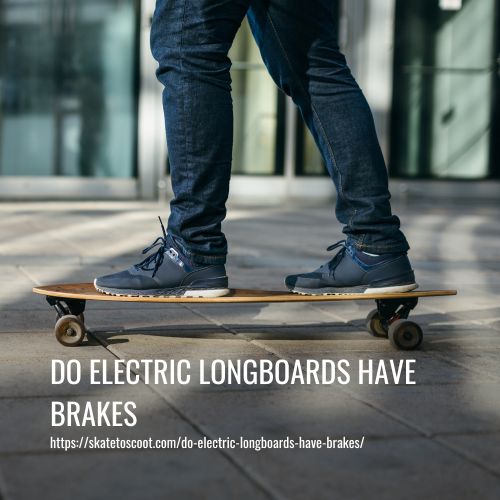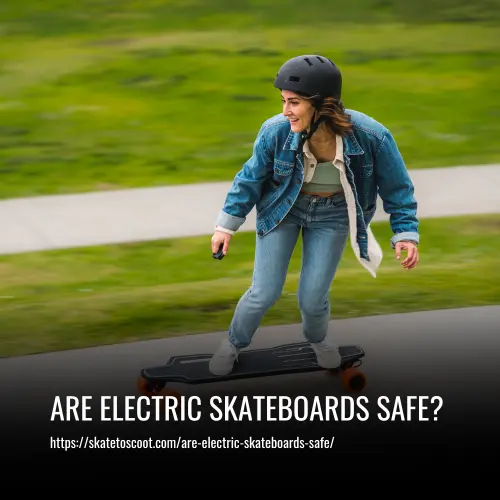As an Amazon Associate we earn from qualifying purchases.
Yes, electric longboards do have brakes. Unlike traditional longboards, electric longboards are equipped with an electric motor that propels the board. To control the speed and braking, riders use a hand-held remote that communicates with the board via a Bluetooth connection. The remote allows the rider to easily control their speed and apply the brakes when needed.
The electric motor that powers the longboard is powered by a battery, which is either connected to the wheels or mounted under the deck. When the rider applies the brakes, the board receives the command from the remote and draws the necessary energy from the battery to slow down or stop.

How to Control the Speed of an Electric Longboard:
Controlling the speed of an electric longboard is an important aspect of riding safely and confidently. There are several ways to control the speed of an electric longboard, each with its own advantages and considerations.
One common method of speed control is through the use of a handheld remote control. These remotes typically have a trigger or a dial that allows the rider to increase or decrease the speed of the longboard. This type of control gives the rider the ability to easily and quickly adjust their speed while riding.
Another factor that can affect speed control is the type of braking system on the electric longboard. Some electric longboards have regenerative braking, which means that the braking system harnesses energy from the wheels and converts it back into power for the battery. This can help extend the battery life while also providing effective braking control.
How Do Electric Longboard Brakes Work?
Electric longboards are becoming increasingly popular for both commuting and recreational purposes. With their powerful electric motors and convenient remote controls, they provide an exciting alternative to traditional longboards. One important aspect of electric longboards is their braking system.
Unlike regular longboards that rely on the rider’s foot to slow down or stop, electric longboards have different types of brakes that make the riding experience safer and more controlled. In this article, we will explore how electric longboard brakes work and the different types of braking mechanisms available.
1. Regenerative Braking System
Regenerative braking is a concept used in electric longboards that allows the kinetic energy generated during braking to be captured and converted into electrical energy. This innovative system not only helps to slow down and stop the longboard but also serves a dual purpose by recharging the longboard’s battery, thus extending its overall range.
The regenerative braking system works by utilizing the electric motor in the longboard. When the rider activates the brake, the electric motor switches into generator mode. As the wheels start to slow down, the motor generates electricity by converting the kinetic energy produced during deceleration.
2. Remote Control Braking System
The remote control braking system on an electric longboard allows the rider to control the speed and apply the brakes wirelessly. The remote control is a key component of the electric longboard, providing a convenient and intuitive way to navigate and control the board.
Typically, the remote control features a thumb-operated joystick or trigger that allows the rider to control the speed of the longboard. By pushing the joystick or trigger forward, the rider increases the speed, while pulling it back slows down or applies the brakes. This functionality provides a seamless control experience, allowing the rider to easily adjust their speed and maintain control over the longboard.
Factors to Consider When Choosing Electric Longboard Brakes
When choosing an electric longboard, one of the key factors to consider is the type of brakes it has. Electric longboards offer different types of braking systems, and understanding these options is essential for both safety and functionality. The type of brakes will determine how effectively and smoothly you can stop your longboard, as well as how much control you have over your speed.
There are various factors to consider when choosing electric longboard brakes, such as the type of braking (regenerative or mechanical), the responsiveness of the brakes, the braking distance, and whether or not the brakes offer different modes for customizable braking.
By carefully considering these factors, you can ensure that you choose an electric longboard with brakes that meet your specific needs and provide a safe and enjoyable riding experience.
1. Maximum Speed Capability
The maximum speed capability of electric longboards can vary based on factors such as weight, terrain, and motor power. The speed limit of an electric longboard is closely related to the combination of these factors. The weight of the rider and any additional gear can affect the top speed. Heavier riders may experience slightly slower speeds compared to lighter ones due to the extra load on the board.
Terrain also plays a significant role in determining the maximum speed. For example, riding uphill or on rough surfaces can decrease the speed compared to riding on flat, smooth pavement. Motor power is another crucial factor in determining the maximum speed of an electric longboard. Boards with higher motor power can usually reach higher speeds, while those with lower motor power may have slower top speeds.
2. Type of Brake Used
There are different types of brakes used in electric longboards, each with its own advantages and disadvantages. The three main types of brakes used in electric longboards are regenerative brakes, mechanical brakes, and electronic brakes.
Regenerative brakes are commonly found in electric longboards and work by converting the kinetic energy produced during braking into electrical energy, which is then used to recharge the onboard battery. This type of braking is known for its efficiency and can help extend the riding range of the longboard. However, regenerative brakes may not be as effective in quickly stopping the board compared to other types of brakes.
Mechanical brakes, on the other hand, are similar to the brakes found in traditional longboards. These brakes use mechanical force, such as friction, to slow down or stop the board. Mechanical brakes can be more reliable and provide a stronger braking force compared to other types of brakes. However, they may require more maintenance and wear down over time.
3. Electronic Speed Controller (ESC) Settings
Firstly, one should take into account their skill level and riding preferences. The ESC settings can be adjusted to control the acceleration and maximum speed of the longboard. For beginners or those who prefer a slower ride, it is recommended to set a lower acceleration and speed limit. On the other hand, experienced riders may opt for higher settings to enjoy a faster and more thrilling ride.
Secondly, the weight of the rider should be considered when adjusting the ESC settings. Heavier riders may require higher power settings to ensure optimal performance, while lighter riders may need lower settings to avoid excessive acceleration or top speed.
Types Of Braking In Longboard
There are several types of braking used in electric longboards, each with its own advantages and disadvantages. The two main types of brakes used in electric longboards are regenerative brakes and mechanical brakes.
1. Regenerative Braking
Regenerative braking is a type of braking system commonly used in electric longboards. It works by converting the kinetic energy of the longboard into electrical energy when the rider applies the brakes. This energy is then stored in the battery, which can be used to power the motor later.
How Regenerative Braking Works:
- Utilizes the Electric Motor: When the rider applies the brakes, the motor switches to a generator mode, converting the kinetic energy of the longboard into electrical energy.
- Energy Storage: The generated energy is fed back into the battery, which can be used later to power the motor.
Advantages of Regenerative Braking:
- Increased Range: By converting kinetic energy into electrical energy, regenerative braking reduces energy wastage during braking. This extends the longboard’s range and is particularly useful in hilly terrain.
- Smooth Braking: Regenerative brakes provide a smooth and gradual deceleration, making it easier to control the longboard, especially in crowded areas or when making sudden stops.
Disadvantages of Regenerative Braking:
- Not Effective for Sudden Stops: While regenerative braking helps slow down the longboard, it may not be sufficient for emergency stops. Riders must still exercise caution and be aware of their surroundings.
- Battery Heating: Regenerative braking can cause the battery to heat up, reducing its lifespan and efficiency.
2. Mechanical Braking
Mechanical braking is a commonly used braking system in electric longboards. This type of braking system relies on friction to slow down or bring the longboard to a complete stop. It is similar to the brakes found on bicycles and is usually found on lower-end electric longboards.
How Mechanical Braking Works:
- Friction for Deceleration: Mechanical braking uses either a pad or a disc that creates friction against the longboard wheel. When the rider applies the brakes, the pad or disc is pressed against the wheel, creating resistance that slows down the longboard.
- Control with Remote Lever: Mechanical brakes are usually operated by a hand lever located on the remote control. This makes it convenient for riders to control the braking intensity and apply it as needed.
Advantages of Mechanical Braking:
- Reliable and Quick Stops: One of the main advantages of mechanical braking is its reliability and effectiveness in emergencies. Unlike regenerative braking, mechanical braking can bring the longboard to a complete stop quickly and efficiently, which is crucial in crowded areas or when unexpected obstacles appear.
- Simple Maintenance: Mechanical braking is a simpler system that is easier to maintain compared to regenerative braking. Unlike regenerative braking, which requires more advanced technology and components, mechanical braking can be serviced and repaired with basic tools and equipment, saving time and costs.
Disadvantages of Mechanical Braking:
- Less Energy Conservation: Unlike regenerative braking, mechanical braking does not convert the kinetic energy of the longboard into electrical energy. Instead, the energy is lost as heat, reducing the overall range of the longboard. This means more energy is required to power the motor, leading to decreased efficiency.
- Potential Jerky Stops: Mechanical braking relies on friction, which can sometimes result in jerky or uneven stops. This can be uncomfortable for riders, especially when making sudden stops. However, with practice and familiarity, riders can learn to anticipate and control the braking to ensure smoother deceleration.
3. Hybrid Braking: The Best of Both Worlds
Hybrid braking is a cutting-edge braking system that combines the benefits of regenerative and mechanical braking in electric longboards. By utilizing both systems, hybrid braking offers enhanced energy conservation and emergency stopping power, making it a top choice for many riders.
How Hybrid Braking Works:
1. Dual Braking Systems: Hybrid braking operates by using regenerative braking first to convert the longboard’s kinetic energy into electrical energy when the brakes are applied. This energy is then stored in the battery for later use. If additional braking force is needed, the mechanical system is engaged to provide extra stopping power.
Advantages of Hybrid Braking:
- Energy Conservation: The inclusion of regenerative braking allows hybrid braking to conserve energy by converting kinetic energy into electrical energy. This means that the longboard can travel a greater distance on a single charge compared to other braking systems, making it more efficient and environmentally friendly.
- Emergency Stopping Power: Hybrid braking combines the emergency stopping capabilities of mechanical braking with the gradual deceleration of regenerative braking. This ensures that riders have maximum control and can stop quickly and efficiently in crowded areas or when faced with unexpected obstacles.
- Smoother and Controlled Braking: With regenerative braking as the initial braking mechanism, the longboard can slow down gradually, providing a smoother and more comfortable braking experience for riders. This feature is particularly advantageous when making sudden stops or navigating downhill slopes.
Disadvantages of Hybrid Braking:
- Complexity and Cost: Hybrid braking systems require more advanced technology and components than other braking systems, making them more complex and expensive. This can increase the overall cost of the electric longboard, which may not be suitable for some riders on a budget.
FAQs
Yes, electric longboards have brakes. They are equipped with different types of braking systems to ensure rider safety and control.
The most common types of brakes found on electric longboards include regenerative braking, mechanical brakes, and electronic brakes.
Regenerative braking is a feature that allows the electric motor to function as a generator, converting kinetic energy back into electrical energy while slowing down the board. This helps recharge the battery and improves the board’s overall range.
Yes, most electric longboards have a remote control that allows riders to accelerate, decelerate, and control the brakes. The remote controller provides riders with precise control over their speed.
When riding an electric longboard, it is essential to wear protective gear such as a helmet, knee pads, elbow pads, and wrist guards. This helps minimize the risk of injuries in case of accidents or falls.
Yes, most electric longboards have a remote control that allows riders to activate the brakes. The remote typically features a brake lever or button that, when pressed, sends a signal to the board to engage the braking system.
Some electric longboards offer additional backup braking options for added safety. These can include automatic braking sequences or back-up mechanical brakes that engage in the event of an electronic braking failure.
Conclusion:
While electric longboards may not have traditional brakes, they do offer a variety of safety features and techniques for slowing down and stopping. Whether it’s regenerative braking, foot braking, or using your body weight to control speed, there are options available to ensure a safe and enjoyable ride.
So, hop on your electric longboard and cruise with confidence, knowing that you’re in control every step of the way!
Amazon and the Amazon logo are trademarks of Amazon.com, Inc, or its affiliates.



